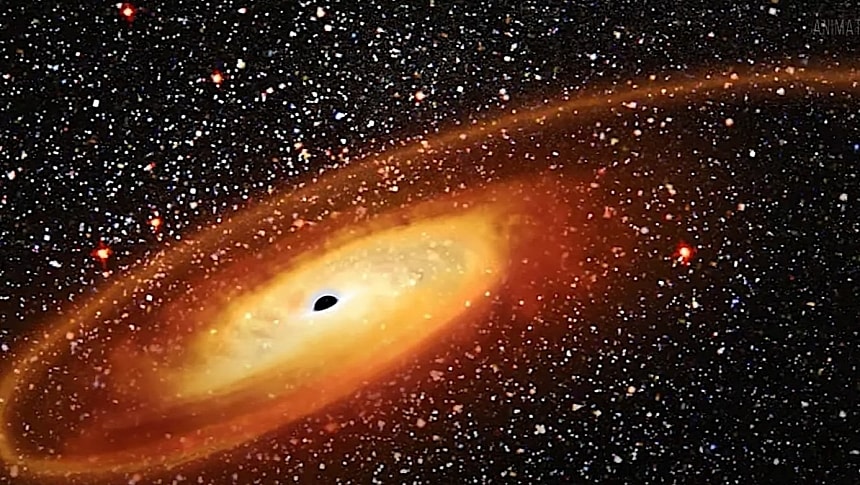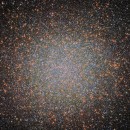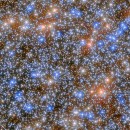The James Webb Space Telescope (JWST) is now exploring the depths of the Universe with youth and vigor, so you'd think the veteran Hubble telescope won't make it in the news all that much. Yet here it is making a discovery so important it got a lot of astronomers all worked up.
Hubble was launched into space in 1990, and it is expected to continue to do its thing well into the 2040. With decades of observations behind it, it will probably fuel exciting discoveries for many more years after that.
The recent finding, made possible by an international team of astronomers led by Maximilian Häberle of the Max Planck Institute for Astronomy in Germany, has to do with black holes and fills in a missing link in the family of celestial objects. And even if it's not based on new observations, but on no less than 500 images snapped over a period of two decades, it shines new light on a type of place light itself can't escape.
We, humans, like to classify black holes by their size as follows: lightweight ones, meaning with a mass of under 100 times that of the Sun in our solar system; intermediate-mass black holes (IMBHs); and supermassive black holes, the ones located smack down in the middle of galaxies, holding them together.
The two types at the ends of the spectrum are relatively common, but the intermediate-mass ones are much rarer (or, we haven't discovered all that many), to the point NASA considers them a missing link.
The images that were studied to find this one show a region of space called Omega Centauri. Located 17,000 light years from our planet, it is comprised of about ten million gravitationally bound stars – a huge collection of suns, ten times more massive than similar clusters, and akin to a galaxy of its own.
The people searching for a black hole up there surveyed no less than 1.4 million of the total, using images that were technically taken when Hubble was still being calibrated. Of that huge bunch, they looked intensely at seven stars "that should not be there."
What that means is these stars move so rapidly that they should have escaped the cluster by now. Yet they are still on location, and the only explanation for this is, according to the astronomers, that there is an intermediate black hole, with a mass of at least 8,200 times that of the Sun, keeping them in place.
The discovery is not definitive, as those involved in this project consider Omega Centauri object a candidate for the title of mid-sized black hole, just like it does with the few others observed until now.
Confirmation should give us a sense of how many of these things are out there. We should also be able to determine if star clusters is where they usually reside, and if they help create supermassive black holes.
The recent finding, made possible by an international team of astronomers led by Maximilian Häberle of the Max Planck Institute for Astronomy in Germany, has to do with black holes and fills in a missing link in the family of celestial objects. And even if it's not based on new observations, but on no less than 500 images snapped over a period of two decades, it shines new light on a type of place light itself can't escape.
We, humans, like to classify black holes by their size as follows: lightweight ones, meaning with a mass of under 100 times that of the Sun in our solar system; intermediate-mass black holes (IMBHs); and supermassive black holes, the ones located smack down in the middle of galaxies, holding them together.
The two types at the ends of the spectrum are relatively common, but the intermediate-mass ones are much rarer (or, we haven't discovered all that many), to the point NASA considers them a missing link.
The images that were studied to find this one show a region of space called Omega Centauri. Located 17,000 light years from our planet, it is comprised of about ten million gravitationally bound stars – a huge collection of suns, ten times more massive than similar clusters, and akin to a galaxy of its own.
The people searching for a black hole up there surveyed no less than 1.4 million of the total, using images that were technically taken when Hubble was still being calibrated. Of that huge bunch, they looked intensely at seven stars "that should not be there."
What that means is these stars move so rapidly that they should have escaped the cluster by now. Yet they are still on location, and the only explanation for this is, according to the astronomers, that there is an intermediate black hole, with a mass of at least 8,200 times that of the Sun, keeping them in place.
The discovery is not definitive, as those involved in this project consider Omega Centauri object a candidate for the title of mid-sized black hole, just like it does with the few others observed until now.
Confirmation should give us a sense of how many of these things are out there. We should also be able to determine if star clusters is where they usually reside, and if they help create supermassive black holes.








